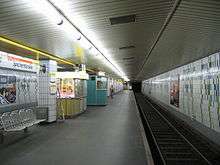Spichernstraße (Berlin U-Bahn)

Spichernstraße is a Berlin U-Bahn station located on the U3 and the U9 in Wilmersdorf neighbourhood. The U3 (then called A II and B II) portion opened on 2 June 1959, replacing the nearby Nürnberger Platz station, which was closed and demolished. The U9 portion, which lies deeper underground, opened on 28 August 1961 as the southern terminus of the new line, then called G. The eponymous street is named after Spicheren in France, site of the 1870 Battle of Spicheren.
The station
The U3 portion of the station is under Spichernstraße; the U9 portion is under Bundesallee. Both have exits at each end of the platform. The station is equipped with escalators but not with lifts and is therefore not completely accessible to the disabled.
U9
The U9 portion of the station, designed by Bruno Grimmek, is standard for this line; it was one of the first built. Like all stations on the line, it has a centre platform 8.85 m wide. Exits at the two ends of the platform lead to Joachimstaler Straße; at the south end a mezzanine and passageways connect to the U3. When the station opened, the walls were pale blue and the hexagonal columns on the platform dark blue. Grey tiles with pink and white patterns and dark blue columns were used in the mezzanine areas.[1] (The initial stretch of Line G had stations in a repeating sequence of pale blue, white, yellow, and pale green colour schemes.[2])
The platform space was completely renovated in 1986/87: both walls and columns were clad in white tiles, with a pattern of coloured tiles on the walls by Gabriele Stierl which is intended to represent the visualisation of a piece of music for an ensemble of 12 instruments, in homage to the nearby Berlin State School of Music and the Performing Arts. The "butterfly ceiling" which was also typical of the stations on this line was replaced with panels, with a relief line in yellow running down the centre as a sharp colour contrast.[1]
Although the station was a terminus until 1971, it did not have a turning area. Trains terminated at the platform, and changed tracks before entering it.[1]
U3
_20130727_3.jpg)
There had not been a station on the A II/B II (now U3) at the interchange point, so the Nürnberger Platz station, located only one or two hundred metres to the north, was replaced with a new station.[3] To facilitate transfers to the new G (now U9), the U3 section of the Spichernstraße station was built with side platforms rather than a centre platform as at the old station. Construction was relatively simple since there was a turning area for the Nürnberger Platz station at the location; trains were routed over the ancillary tracks and the new platforms constructed on the site of the former main tracks.[4]
The station has exits at both ends. A passenger tunnel under the tracks connects the two platforms; the connection to the U9 is at the south end of the station.[4] This part of the station still has pale blue tiled walls; the mezzanine and the passage leading to the U9 have sand-coloured tiles.[5]
References
- 1 2 3 U9 Spichernstraße, Berliner-Untergrundbahn.de (German)
- ↑ Die ursprüngliche "Linie G", Berliner-Untergrundbahn.de (German)
- ↑ At Berliner-Untergrundbahn.de, U3 Spichernstraße states "around 200 metres", while Die Wilmersdorf-Dahlemer Schnellbahn Teil 1: Die Wilmersdorfer U-Bahn states "100 metres away". (German)
- 1 2 U3 Spichernstraße, Berliner-Untergrundbahn.de
- ↑ Die Wilmersdorfer U-Bahn, Berliner-Untergrundbahn.de
External links
| Wikimedia Commons has media related to Spichernstraße (Berlin U-Bahn). |
- Map of station and surroundings, Berliner Verkehrsbetriebe (pdf) (German)
| Preceding station | Berlin U-Bahn | Following station | ||
|---|---|---|---|---|
towards Krumme Lanke | U3 | towards Nollendorfplatz |
||
towards Rathaus Steglitz | U9 | towards Osloer Straße |
Coordinates: 52°29′48″N 13°19′52″E / 52.49667°N 13.33111°E